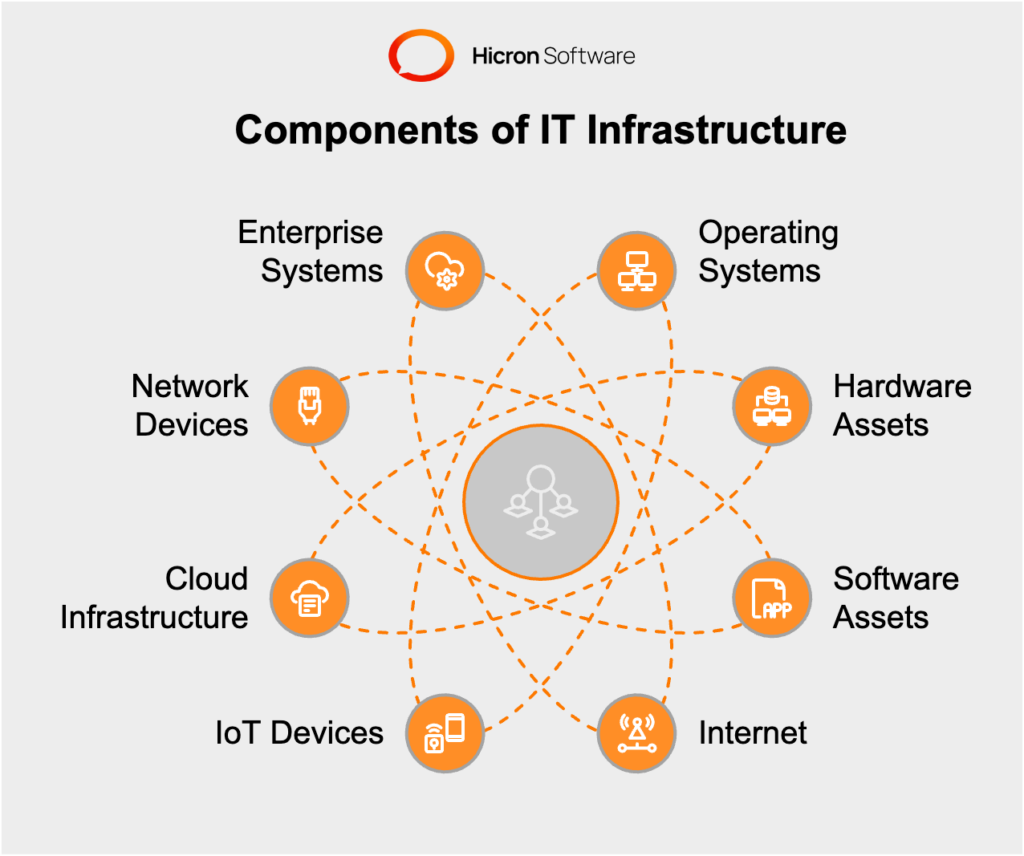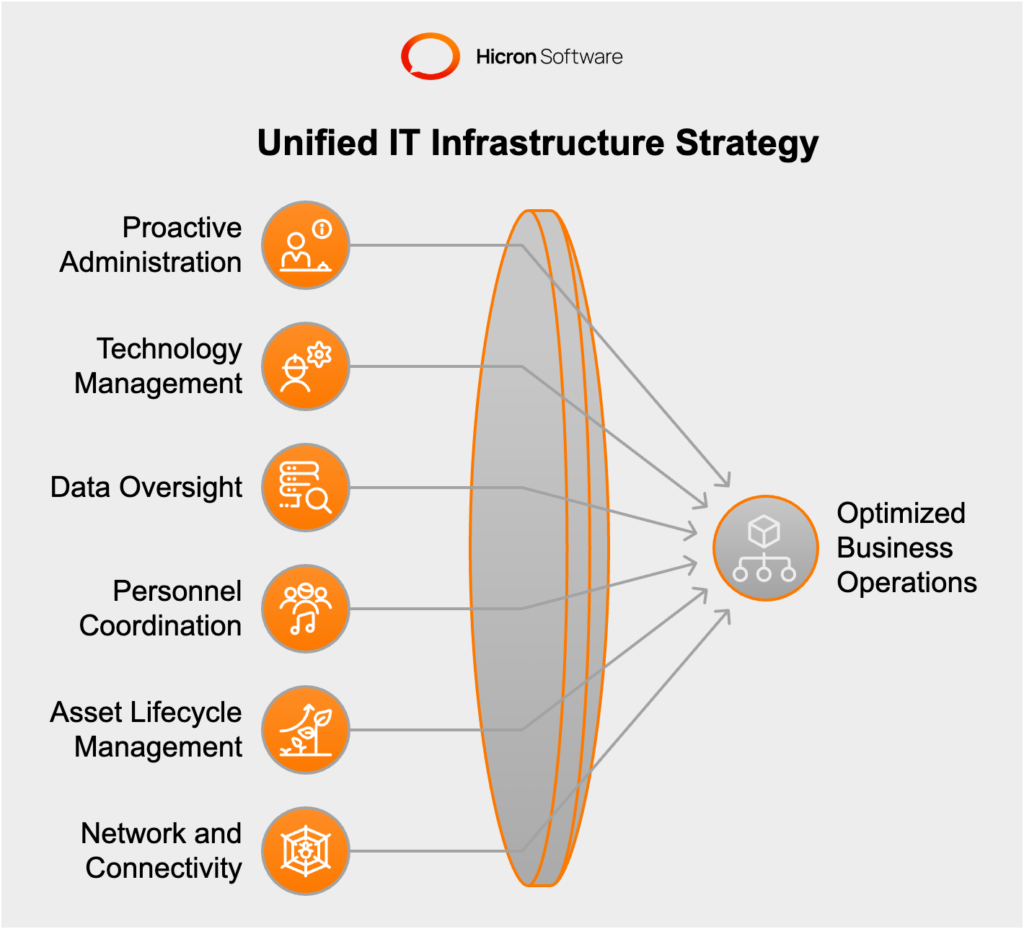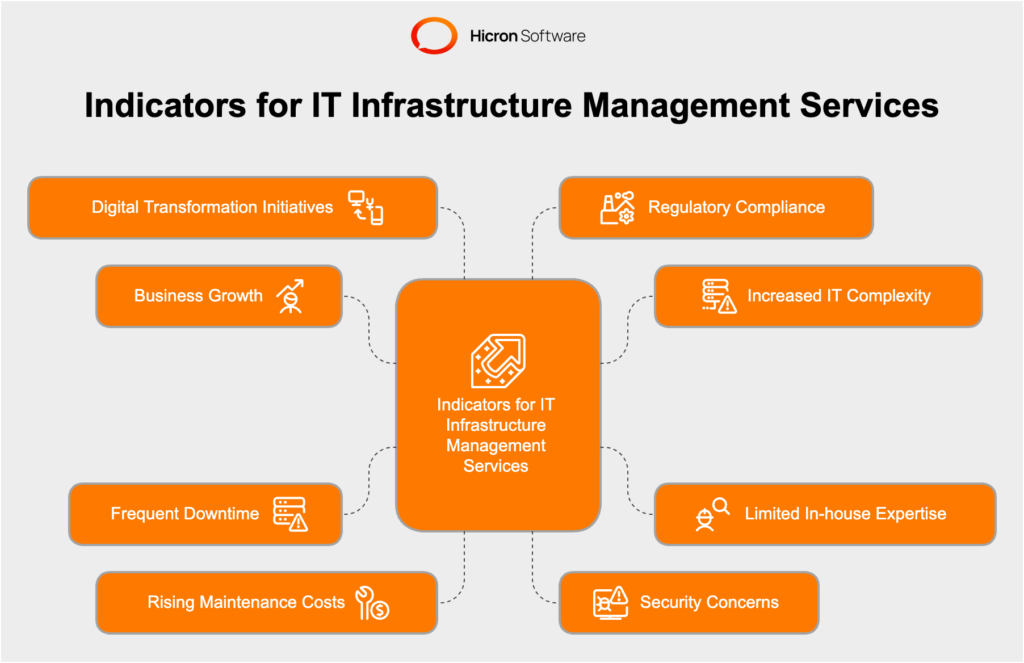6 Solutions for Cloud Migration Strategies You Should Know
- March 27
- 21 min

In today’s digital world, your business’s IT infrastructure plays a great role in its success. It empowers users and drives the applications that keep the business running smoothly. However, traditional infrastructures struggle to keep up with rapidly accelerating changes and compressed transformation. As such, modernizing IT infrastructure has become a necessity. It can help you move towards a smarter, more flexible, and cost-effective software-defined infrastructure that’s always prepared to seize new opportunities.
Check our IT Infrastructure Management Services
With digitalization taking center stage, we understand the pressing need for reliable IT solutions and infrastructure services that keep up with the times. Our IT Infrastructure Management Services allow us to offer our customers what is the best.
But first, let’s learn more about this topic in our article.
Managing today’s rapidly evolving and increasingly complicated IT infrastructure can be quite challenging, especially when you have other critical organizational responsibilities. Essentially, all the physical and non-physical assets that underpin business operations make up the infrastructure. This includes people, processes, and things. While customers generally don’t get a glimpse of backend operations that facilitate the delivery of services and products, any disruptions or malfunctions affecting these operations can quickly become apparent.

The IT infrastructure, also known as the organization’s information system, encompasses all components related to the IT machine’s function. Key elements of the information system, which require ongoing management and protection, are:
These are the fundamental components that form the building blocks of your organizational IT infrastructure. The primary focus of your MSSP and provider is on these components, to ensure correct and secure operation.
IT infrastructure management service (IMS) involves proactive administration and management of technology, information, data, and personnel from desktops to cloud-based systems, including networking, storage, security, and other areas. The primary objective of IMS is to minimize downtime, optimize productivity, and support the overall business objectives. By implementing IMS, your organization gains clear boundaries, outlining how your business infrastructure is managed. Additionally, your enterprise IT team assumes responsibility for various functions, including asset lifecycle management, network and connectivity issues, and monitoring of mobile devices and their maintenance.

The IT infrastructure is the backbone of an enterprise in the digital economy, requiring services to be available continuously for seamless internal and external stakeholder experiences. However, the rise of hybrid and multi-cloud deployments has increased complexity and costs. With insufficient platform-native integration from leading cloud hosting providers, it becomes challenging to interface between multiple platforms. This lack of compatibility and integration poses an enormous burden on IT infrastructure management, leading to higher business costs and the diversion of resources from larger projects.
Traditional infrastructure refers to the practice of owning and managing components such as data centers, data storage, and equipment within a company’s premises. This setup can be costly in terms of hardware requirements, such as servers, power, and physical space.
Cloud infrastructure refers to the various components and resources essential for cloud computing. You can establish a private cloud by building it yourself with dedicated resources. An alternative is to rent cloud infrastructure from providers such as Amazon, Google, IBM, Alibaba, Oracle, or Microsoft for accessing public clouds. By incorporating some workload portability, orchestration, and management across multiple clouds, you can benefit from a hybrid cloud.
Hyperconverged infrastructure
Hyperconverged infrastructure (HCI) allows the management of compute, network, and data storage resources from one interface. By bundling software-defined compute and data storage, HCI offers support for modern workloads with scalable architectures on standard hardware.
A comprehensive understanding of IT infrastructure management relies on specific component knowledge as well as familiarity with key management tasks. The three sub-categories of IT infrastructure management include systems management, network management, and storage management.

Systems management is a vital component of IT infrastructure management as it covers a wide range of key activities. It includes the administration of IT assets in a data center and is typically overseen by a Chief Information Officer (CIO) or Chief Technical Officer (CTO). Their role involves managing the integration of new applications and third-party services into the organization’s hybrid cloud environment and overseeing the daily data center operations.
Activities that come under systems management include security-focused initiatives like intrusion detection prevention and security information and event management. Also, log management, workload automation, configuration management, and the integration of cloud-based applications and services all fall under systems management.
Network management involves managing and configuring security networks by IT security and operations analysts, ensuring proper allocation of resources to necessary applications and services with maintained quality and availability. Additionally, IT operators must maintain transparency into the network to protect the organization against unauthorized access and data breaches.
Effective IT infrastructure management includes monitoring and managing valuable data storage technologies and resources such as virtualization, storage provisioning, data compression, and data security. Automated storage provisioning and data compression can improve data center performance, while virtualization techniques can enable businesses to allocate storage resources more efficiently. Guarding against data loss or theft is also essential and can be achieved through management techniques like data replication, mirroring, and security.
Cloud computing service providers have revolutionized how IT organizations manage their infrastructure, a key for daily activities. Before, organizations had no choice but to own and operate their own IT systems when considering digital transformation. Today, cloud computing has made it possible for organizations to outsource infrastructure management in a more convenient manner with three common models to choose from.
IaaS
Infrastructure-as-a-Service (IaaS) is a model of outsourcing physical infrastructure and its management to a third- storage services for the IT organization.
PaaS
Platform-as-a-service (PaaS) is a model in which an IT organization outsources its development platform and physical infrastructure to a third-party service provider. Such infrastructure includes networking and storage infrastructure, servers, virtualization, operating systems, middleware, and runtime.
SaaS
The Software-as-a-service (SaaS) model allows IT organizations to access finished software products via a web-based portal, managed by a third-party cloud service provider. This eliminates the burden of managing and administering the software, enabling companies to access valuable business applications with ease.
#1 Reduced IT spending: You do not need to purchase additional office space or keep IT staff updated with new technology.
#2 Operational improvement: You gain access to technical expertise, cutting-edge tools, and advanced methodologies. Additionally, you receive a comprehensive IT infrastructure analysis that assists in detecting and eliminating operational issues.
#3 Improve agility and efficiency: Proactively manage all IT infrastructure layers, implement 24/7 performance monitoring, and establish change and configuration management to ensure efficient and responsive IT operations.
#4 Improve cost-efficiency: Do it by avoiding financial losses resulting from unplanned downtime, optimizing IT support and maintenance expenses, and reducing hiring expenses for in-house IT teams.
#5 Revenue maximization: Optimizing your business infrastructure can drive revenue growth by streamlining technology and eliminating silos, ultimately improving work efficiency. Migrating from on-premises to cloud-based solutions offers vast benefits, including streamlined processes, superior data management, and interoperability for even small-scale businesses. The cost reduction and improved service quality enabled by this migration attract and retain clients, boosting long-term business success.
#6 Scalability: One of the primary obstacles to the on-premises IT infrastructure model is the difficulty in scaling the business. However, opting for managed IT infrastructure management solutions can optimize your IT environment while dramatically reducing the challenges involved with configuring servers and purchasing new equipment, every time you need to expand your services. More recently, cloud services have made a significant impact on businesses as they offer flexibility and the ability to scale up your IT infrastructure, making it an excellent option for organizations.
#7 Boosts productivity and increases employee engagement: An efficient IT Infrastructure is vital for optimizing processes, connecting departments, and providing stakeholders with a comprehensive view that fosters agility, operations, and best practices. Implementing process automation through IT Infrastructure frees existing resources for more productive tasks. Additionally, a robust digital workplace platform eliminates the need for employees to juggle multiple tools to perform their roles. With productivity and collaboration tools easily accessible, employees can perform at optimal levels, resulting in increased productivity.
#8 Reduce outages and downtime: An organization’s business operation can suffer from financial loss due to any infrastructure at risk, such as outages, downtime or failure. An outdated and inefficient on-premises IT infrastructure model can harm profitability. Thus, migrating to cloud infrastructure is a wise decision for transforming the business. It can lower maintenance costs, refine system manageability, and ultimately reduce downtime.
High-standard IT infrastructure is essential for digital transformation and emerging technologies. With digital-first approaches being embraced by every industry, businesses need to adopt future-proof IT infrastructure management services.
How to succeed in business transformation?
Learn more about our services and get out the most for your business today and also read about how you can make a proper business transformation.
Read about digital transformation in Latin America.
Infrastructure management is the coordinated administration of technical and operational components, comprising hardware, software, facilities, policies, processes, and equipment, to optimize business efficacy. It can be categorized into three domains: systems management, network management, and storage management. Organizations deploy IT infrastructure management to achieve various objectives: mitigate redundant efforts, comply with IT standards and regulations, enhance information transmission, adapt to evolving business markets, promote IT interoperability, efficiently manage changes, and reduce overall IT expenditure.
Effective management of IT infrastructure allows organizations to optimize IT resources in alignment with business goals and priorities. By aligning IT strategy with business objectives, technology can be leveraged to add value to the organization rather than draining resources. Instead of managing computing technology for each line of business separately, IT infrastructure management consolidates the management of various components including servers, applications, storage, networking, security, and facilities. This integrated and automated approach enhances IT efficiency and agility, ultimately impacting business profitability.
One way to improve change management and protect interdependencies in converged IT environments is to use IT infrastructure management tools. SUSE Manager, for example, is a program that manages and monitors a variety of hardware architectures, hypervisors, and cloud platforms, allowing enterprises to centralize the management of their Linux systems, virtual machines, and other software-defined infrastructure (SDI) components. It provides automated software, assets, patches, and configuration management, as well as system provisioning, orchestration, and monitoring. SUSE Manager improves efficiency and performance by automating tasks such as server deployment, updating, patching, and configuration across physical, virtual, and cloud environments.
Capitalizing on IT Infrastructure Management Services is essential for businesses that want to optimize their IT ecosystem, improve operational efficiency, and stay competitive. Here are some key indicators that signal it’s time to invest in IT Infrastructure Management Services:
Business growth
As your business expands, so does the complexity of your IT infrastructure. Investing in IT Infrastructure Management Services can help you scale your IT systems effectively while maintaining performance and reliability.
Increased IT complexity
If managing your IT infrastructure has become increasingly complex and time-consuming, it’s a sign that professional management services might be needed to streamline processes and improve efficiency.
Limited in-house expertise
If your internal IT team lacks the necessary skills or resources to manage your growing infrastructure efficiently, it’s time to consider outsourcing to experts who specialize in IT Infrastructure Management Services.
Frequent downtime and performance issues
If you’re experiencing regular system outages or performance problems, investing in IT Infrastructure Management Services can help identify the root cause and implement proactive measures to minimize future occurrences.
Rising maintenance costs
When the cost of maintaining your IT infrastructure starts to outweigh the benefits, it’s time to explore more cost-effective solutions, such as IT Infrastructure Management Services.
Security concerns
With the increasing number of cyber threats and the importance of data security, partnering with an IT infrastructure management provider can help strengthen your security posture and protect your critical assets.
Digital transformation initiatives
If your organization is undergoing digital transformation, investing in IT Infrastructure Management Services can ensure a smooth transition and help you navigate the complexities of adopting new technologies.
Regulatory compliance
If your business operates in a highly regulated industry, IT Infrastructure Management Services can help you maintain compliance with industry-specific regulations and standards.

In summary, it’s crucial to capitalize on IT Infrastructure Management Services. These services can optimize your IT ecosystem, enhance operational efficiency, and support your business’s long-term success. If you look for such services, get in touch with us.
